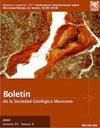伊朗中部Qom组下中新世珊瑚红藻富粒岩相古生态
IF 0.4
4区 地球科学
Q4 GEOLOGY
引用次数: 0
摘要
本文对伊朗中部Vartun剖面下中新世(阿基坦期)Qom组碳酸盐岩中富含珊瑚红藻的浅滩颗粒岩相进行了古生态学研究。所鉴定的珊瑚红藻主要是非膝状的,尽管在薄片分析中也发现了非常罕见的膝状珊瑚。已鉴定的藻类有:黑藻科(Lithothamnion cf. valens, Lithothamnion cf. roveroti, Lithothamnion cf. peleense, Lithothamnion spp.), Mastophoroideae科(Neogoniolithon sp.,海绵藻类spp.,海绵藻类cff . fruticulosus),孢子石科(Sporolithon spp.和Sporolithon cff . airoldii)和膝状珊瑚(Corallina)。藻类类群主要呈块状和果状生长。前者的优势与识别的浅滩环境中高水能相一致。中新世下藻类的存在表明碳酸盐沉积发生在阿基坦期温暖的热带至亚热带海洋环境中。同样,高水能和泥沙搅拌导致了破碎、磨损和断裂等地貌学特征。本文章由计算机程序翻译,如有差异,请以英文原文为准。
Paleoecology of Lower Miocene coralline red algae-rich grainstone facies in the Qom Formation (Vartun section, central Iran)
In this paleoecological study we focused on coralline red algae-rich shoal grainstone facies in the Lower Miocene (Aquitanian) carbonates of the Qom Formation in the Vartun section in central Iran. The identified coralline red algae are mainly non-geniculate, although very rare geniculate forms of corallines were also recognized in thin section analysis. The identified algae are represented by Melobesioideae (Lithothamnion cf. valens, Lithothamnion cf. rovereoti, Lithothamnion cf. peleense, and Lithothamnion spp.), Mastophoroideae (Neogoniolithon sp., Spongites spp., and Spongites cf. fruticulosus), Sporolithon spp. (Sporolithon spp. and Sporolithon cf. airoldii), and geniculate coralline (Corallina). The algal taxa mainly display fruticose and lumpy growth forms. The dominance of the former is consistent with high water energy in the identified shoal environment. The presence of Lower Miocene algae indicates that deposition of carbonates took place in warm tropical to subtropical waters in a euphotic marine environment during the Aquitanian. Likewise, high water energy and sediment agitation resulted in taphonomic features such as fragmentation, abrasion, and disarticulation.
求助全文
通过发布文献求助,成功后即可免费获取论文全文。
去求助
来源期刊
CiteScore
1.40
自引率
12.50%
发文量
34
审稿时长
50 weeks
期刊介绍:
The Boletín de la Sociedad Geológica Mexicana is a completely free-access electronic journal published semi-annually that publishes papers and technical notes with its main objective to contribute to an understanding of the geology of Mexico, of its neighbor areas, and of geologically similar areas anywhere on Earth’s crust. Geology has no boundaries so we may publish papers on any area of knowledge that is interesting to our readers.
We also favor the publication of papers on relatively unfamiliar subjects and objectives in mainstream journals, e.g., papers devoted to new methodologies or their improvement, and areas of knowledge that in the past had relatively little attention paid them in Mexican journals, such as urban geology, water management, environmental geology, and ore deposits, among others. Mexico is a land of volcanos, earthquakes, vast resources in minerals and petroleum, and a shortage of water. Consequently, these topics should certainly be of major interest to our readers, our Society, and society in general. Furthermore, the Boletín has been published since 1904; that makes it one of the oldest scientific journals currently active in Mexico and, most notably, its entire contents, from the first issue on, are available online.

 求助内容:
求助内容: 应助结果提醒方式:
应助结果提醒方式:


